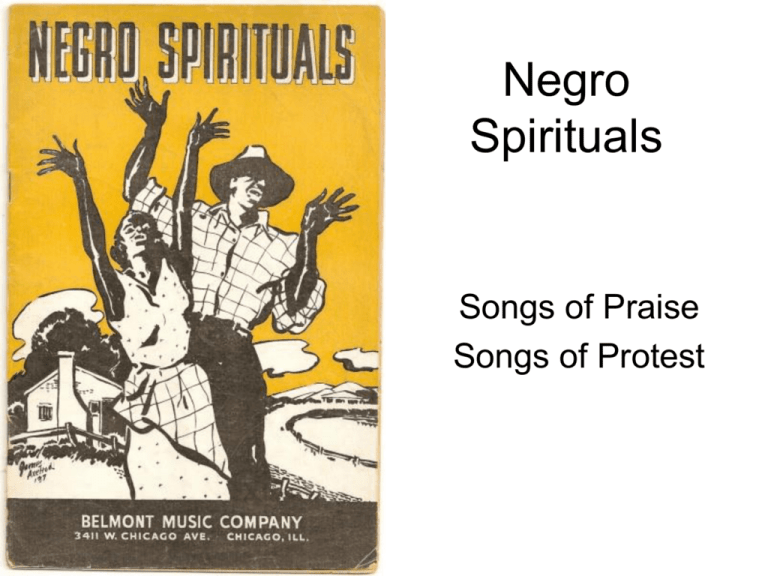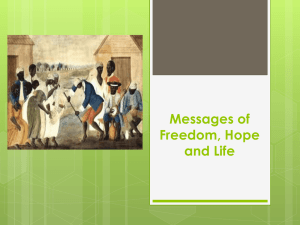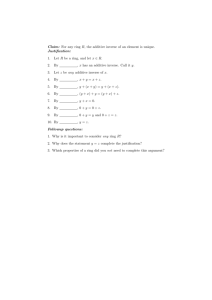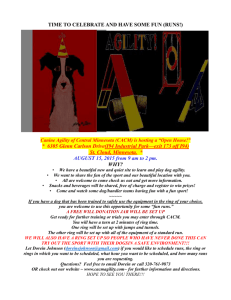Negro Spirituals PPT
advertisement

Negro Spirituals Songs of Praise Songs of Protest Origins Slave holders did not allow singing or dancing. Slaves met in secret to share and sing. These “camp meetings” or “bush meetings” were the precursors of revivals. The songs sung were the early form of the spiritual, called “corn ditties.” “Shouts” These spirituals, inspired by African music, were accompanied with dancing, hand clapping, and foot tapping. Shouts were banned by educated ministers. After a regular prayer service, congregations would stay afterwards for a “ring shout” in which members would arrange themselves in a ring. The music would start, perhaps with a spiritual, and the ring would begin to move, slowly, then faster and faster. The same musical phrase was repeated over and over for hours. Women screamed and fell. Men, exhausted, dropped out of the ring. Work Songs Slaves were allowed to sing “chain gang” songs to help coordinate efforts for hauling a fallen tree or moving a heavy load. “Quiet” songs were allowed as long as the lyrics were not anti-slave owner. Spirituals and the UGRR “Wade in the Water”, “The Gospel Train”, and “Swing Low, Sweet Chariot” directly refer to the Underground Railroad. The lyrics were “code” to allow the slaves to communicate about escaping without suspicion from the authorities. “Wade in the Water” Fugitive slaves could escape in several ways. First, they had to walk at night, using hand lights and moonlight. To hide the scent of their tracks from the hounds, they walked through or “waded” in water. “Gospel Train” The places where slaves were dropped off and transferred to safe havens were called “stations.” The references to trains in spirituals represent travelling to freedom. “Swing Low, Sweet Chariot” This song refers to Ripley, a “station” of the Underground Railroad. Ripley was atop a hill by the Ohio River, which was difficult to cross. The slaves referred to the Ohio as the Jordan, and had to wait for others to come and help them. Thus, the line, “I looked over Jordan and what did I see? A band of angels coming after me.” References to the Promised Land, “Sweet Caanan” or home indicate a free, safe, happy country in which to live. Types of Spirituals Dr. Watts Call and Response Chant Slow, sustained long-phrase melody Syncopated melody Dr. Watts An English minister, Dr. Watts’ hymns were embraced by the black religious community leaders who wanted slaves to move into more sophisticated music than “non-sensical chants, catches, and hallelujah” songs. The Watts style hymn was slow, and punctuated after each praise by the leader’s intoning the next line of the hymn. The deacon or cantor set the pitch and reminded the words in halfsinging, half-chanting tones. Call and Response For a Call and Response chant, the preacher or leader sings one verse and the congregation (chorus) answers him with another verse. “Swing Low, Sweet Chariot” is an example of a Call and Response chant hymn. Slow, sustained, long phrase melody A long phrase melody is exactly that: the lines of the hymn are lengthy and the rhythm is slow. “There is a Balm in Gilead” is an example of the slow, sustained, long phrase melody. Syncopated Melody This type of hymn is usually fast and the rhythm features a “swing.” These hymns are sung by a group (not a soloist) and the rhythm is based on the swinging of head and body. The swaying of the body marks the regular beat, but more or less strict in time. The singer takes the basic beat, almost monotonously, with his left hand while he juggles it with his right hand. “Old Time Religion” and “Standin’ in the Need of Prayer” are examples of Syncopated Melody. Continued Tradition Dr. Martin Luther King, Jr. uses the Call and Response cadence of the spiritual to build his “I Have a Dream” speech. He incorporates figurative and literal meanings in the text, using the anaphoric “call” to get the audience’s “reponse.” “I Have a Dream” “So let freedom ring from the prodigious hilltops of New Hampshire. Let freedom ring from the mighty mountains of New York. Let freedom ring from the heightening Alleghenies of Pennsylvania. Let freedom ring from the snow-capped Rockies of Colorado. Let freedom ring from the curvaceous slopes of California. But not only that – let freedom ring from Stone Mountain of Georgia. Let freedom ring from Lookout Mountain of Tennessee. Let freedom ring from every hill and molehill of Mississippi – from every mountainside! When we let freedom ring, when we let it ring from every village and every hamlet, from every state and every city, we will be able to speed up that day when all of God’s children, black men and white men, Jews and Gentiles, Protestants and Catholics, will be able to join hands and sing in the words of the old Negro spiritual, “Free at last, free at last! Thank God Almighty, we are free at last!” The lyrics of Negro spirituals were tightly linked with the lives of their authors: slaves. While work songs dealt only with their daily lives, spirituals were inspired by the message of Jesus and his Good News (gospel) of the Bible, “You can be saved.” They are different from hymns and psalms because they were a way of sharing the hard condition of being a slave. Today Hip Hop, Rap, and Chant continue the tradition of the spiritual: Hip Hop follows the classic Call and Respond structure. Rap reflects the Syncopated Melodies. Chant allows for meditation with its long, slow melody and repetitive phrasing.









